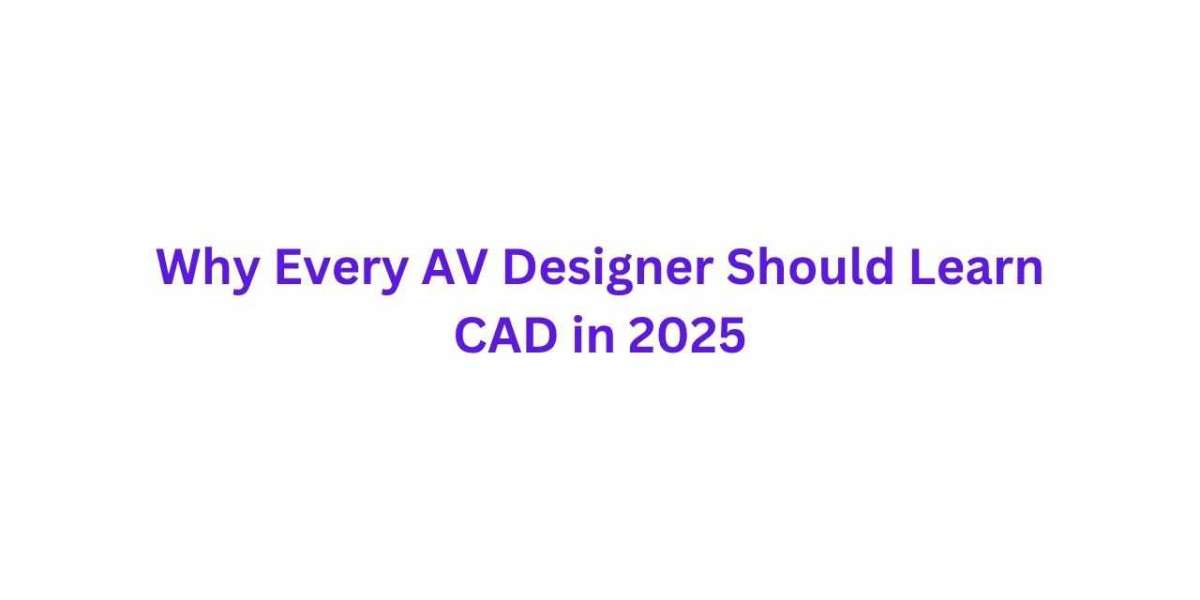In 2025, the AV industry continues to evolve at an unprecedented pace. With client expectations growing, projects becoming more complex, and technology stacks expanding rapidly, the need for precision and efficiency is more important than ever. One skill that now stands as a non-negotiable for AV designers is proficiency in CAD drafting. CAD, or Computer-Aided Design, is no longer just a tool for architects or engineers. It is a foundational necessity for anyone designing AV systems in today’s built environments.
This blog explores why every AV designer should learn CAD in 2025, how it enhances project delivery, and the direct impact it has on communication, efficiency, and design accuracy.
1. CAD is Now the Industry Standard
Regardless of project size, CAD is now the default expectation in most professional AV environments. Whether you are working on a conference room, a stadium, or a smart building, clients and contractors expect AV drawings that integrate seamlessly with architectural and electrical plans. This alignment requires a working knowledge of CAD.
As AV design moves further into the architectural design process, your ability to communicate using the same tools as architects, engineers, and general contractors is critical. If you do not speak the same visual and technical language as your collaborators, your drawings will feel outdated and less credible.
2. It Streamlines Collaboration Across Disciplines
Designing AV systems is rarely done in isolation. AV designers often work alongside professionals from different trades, including HVAC, security, lighting, IT, and electrical engineering. CAD allows all stakeholders to work from a unified digital environment. This cross-trade coordination is essential to prevent conflicts in equipment placement, cabling routes, and rack room layouts.
When AV designers use CAD, they can overlay their drawings with other systems, catch potential clashes early, and make real-time modifications. This proactive coordination reduces costly change orders and ensures a smoother project handoff.
3. Clients Expect Professional, Clear Visuals
Modern clients want to see exactly what they are getting. A well-drafted CAD drawing brings clarity to your proposals and helps clients visualize cable paths, equipment rack layouts, speaker placements, and more. Clear documentation builds trust.
A clean set of CAD drawings can often be the difference between winning or losing a bid. When clients compare proposals, the one with the most detailed and professional presentation will often stand out. In 2025, that standard means you need to know how to produce high-quality CAD drawings.
4. Learning CAD Improves Your Technical Thinking
CAD drafting is not just a technical skill; it improves how you think about space, systems, and integration. The process of laying out AV devices, tracing cable runs, and accounting for spatial constraints strengthens your understanding of real-world challenges. You begin to design with constructability in mind.
With CAD proficiency, you are more likely to produce systems that are not only functional but also easier to install, maintain, and upgrade. This holistic design approach is what sets experienced AV professionals apart.
5. You Stay Competitive in the Job Market
AV professionals who can draft their own CAD drawings are significantly more valuable to employers and clients. Instead of relying on a separate drafter or design assistant, you can take your designs from concept to completion independently.
In 2025, job descriptions for AV designers, engineers, and consultants increasingly list CAD skills as essential. Without this ability, you may find yourself passed over for top-tier roles or freelance projects. Learning CAD is not just about project efficiency. It is about career security and growth.
6. You Can Leverage Automation Tools and AI Integration
Many advanced AV design platforms now offer AI-enhanced tools that integrate with CAD software. These tools allow you to automate repetitive tasks such as generating cable schedules, device lists, and rack elevations. But to take full advantage, you must have a baseline understanding of CAD workflows.
Design automation is only as good as your input. If you understand how CAD works, you can input data more accurately, verify the output more confidently, and modify auto-generated documents when needed. Learning CAD opens the door to a much more efficient design process, especially when paired with intelligent drafting platforms.
7. Remote Work and Digital Design Are Here to Stay
As remote and hybrid work models persist, being able to work independently on CAD files is essential. You may not always have a team or office-based drafter to support you. Clients expect digital deliverables that can be reviewed on shared platforms like Revit, AutoCAD, or XTEN-AV.
Learning CAD ensures that you can operate effectively in a fully digital design workflow. It gives you the freedom to contribute from anywhere and ensures your work is consistent with global standards.
8. Learning CAD Is More Accessible Than Ever
In 2025, learning CAD is no longer limited to expensive courses or on-the-job training. There are countless online tutorials, certification programs, and even free versions of CAD software available to help you build your skills.
Additionally, AV-focused platforms like XTEN-AV make learning CAD much easier by combining user-friendly interfaces with templates and libraries specifically tailored to AV projects. If you are just starting out, tools like XTEN-AV provide a great entry point to understanding AV CAD Software workflows.
Final Thoughts
AV design is now inseparable from CAD. As the demands of clients grow, and as integration with other building systems becomes tighter, AV professionals must evolve. Learning CAD is not just about producing better documents. It is about becoming a better communicator, problem solver, and collaborator.
In 2025, every AV designer who wants to remain relevant, efficient, and competitive should make CAD proficiency a priority. With powerful platforms like XTEN-AV and accessible training resources, there has never been a better time to invest in this essential skill.
Read more: https://techwaveav.alboompro.com/post/best-cad-software-options-for-av-designers-in-2025








